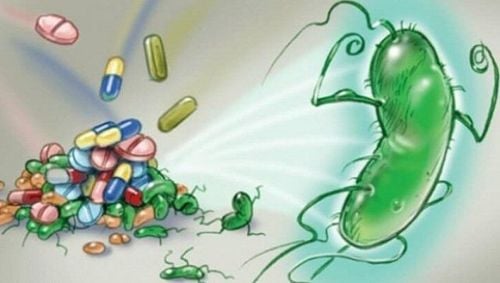This is an automatically translated article.
Hyoscin - N - butylbromide is an active ingredient commonly indicated for use in acute spasms such as abdominal, renal or biliary colic, and is also used in gastroduodenal endoscopy to help prevent smooth muscle spasms. This active ingredient is also the main ingredient of Vincopane.
1. What is Vincopane?
Formula for making Vincopane for 1 ml tube includes: Hyoscin - N - butylbromide content 20mg, Sodium chloride and distilled water for injection just enough 1ml. Dosage form of the drug Vincopane : Solution for injection.
Hyoscin - N - Butylbromide has antispasmodic effects on gastrointestinal smooth muscle, biliary tract, genitourinary tract and urinary tract. Hyoscin - N - Butylbromide acts as a muscarin antagonist, preventing the effect of Acetylcholine by blocking the combination of Acetylcholine with muscarinic receptors in the nerve-affecting parts of smooth muscle. . Hyoscin - N - Butylbromide is a quaternary ammonium derivative, so it does not enter the central nervous system and has no anti-acetylcholine effect in the central nervous system.
2. What are the effects of Vincopane?
2.1. Indications Vincopane is indicated in acute spasms such as abdominal, renal or biliary colic; Vincopane is indicated in radiology for the differential diagnosis of mechanical obstruction due to spasm and used to reduce spasm in radiographs of the kidneys and ureters; Vincopane is indicated in gastroduodenal endoscopy to prevent smooth muscle spasms. 2.2. Contraindications Do not use Vincopane for people with hypersensitivity to Hyoscin - N - butylbromide or any of its ingredients. Do not use Vincopane for people with glaucoma, enlarged prostate with urinary retention, mechanical narrowing of the gastrointestinal tract, tachycardia, enlargement of the colon, myasthenia gravis.
3. Dosage and how to use Vincopane
Dosage for adults
In acute abdominal pain, it can be administered slowly intravenously, intramuscularly or subcutaneously with a dose of 1 ampoule of Vincopane (20mg)/time, repeated after 30 minutes if necessary. During endoscopy, inject 1 ampoule of Vincopane, then inject again every 30 minutes if necessary. The daily dose of Vincopane should not exceed 100mg (5 ampoules). Dosage for children: In severe cases, each injection is 1⁄4 ampoules of Vincopane, 3 times/day.
4. Undesirable effects of the drug Vincopane
Common side effects of Vincopane: Dry mouth, visual disturbances, tachycardia, constipation and urinary retention, allergic reactions - especially skin reactions are also possible but rare. , in people with a history of asthma or allergies may also occur difficulty breathing.
5. Drug interactions of Vincopane
Vincopane increases the effect of antimuscarinic drugs such as tricyclic antidepressants, antihistamines, Amantadine, Phenothiazines and other anti-muscarin drugs (Ipratropium, Tiotropium) when used concurrently. Concomitant use of Vincopane with a dopamine antagonist such as metoclopramide may reduce the effect of both drugs on the gastrointestinal tract. Vincopane may enhance the tachycardia-inducing effects of beta-adrenergic drugs. Pregnancy: There is no evidence to confirm that Vincopane has adverse effects when used during pregnancy in humans. In animal studies, Vincopane also showed no risk. However, Vincopane should not be used during pregnancy, especially during the first trimester, unless the expected benefit of Vincopane outweighs any possible risks to the fetus. Lactation: There is insufficient information on the excretion of Hyoscin butylbromide and its metabolites in breast milk that a risk of breastfeeding may occur. Therefore, the use of Vincopane during breastfeeding is not recommended. Vincopane may cause drowsiness and fatigue. Therefore, do not drive or operate machinery while taking Vincopane.
6. Be careful when using Vincopane
Vincopane is used with caution in cases of tachycardia due to heart failure, thyrotoxicosis, heart surgery because the drug can accelerate the heart rate; Vincopane can reduce sweating so Vincopane should be used with caution in patients with fever; Vincopane causes an increase in intraocular pressure, so do not use Vincopane to treat narrow-angle glaucoma; When injecting Vincopane, anaphylaxis may occur, so it is necessary to monitor the patient after injection.
Please dial HOTLINE for more information or register for an appointment HERE. Download MyVinmec app to make appointments faster and to manage your bookings easily.













